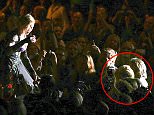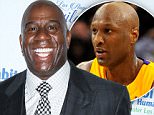The DNA test 'that reveals if you're gay': Genetic code clue is 70% accurate, claim scientists
- Researchers studied the DNA of 47 pairs of adult male identical twins
- Distinct patterns of modifications to DNA were linked to homosexuality
- Known as epigenetics, these changes are thought to occur in the womb
Scientists claim they can predict whether someone is gay or straight with up to 70 per cent accuracy by looking at their DNA.
It has long been believed that sexuality has a biological basis – with certain genes linked to being gay.
But the claim sexual behaviour can be predicted by such a high degree was described as 'bold' by British scientists.

Researchers found distinct patterns of molecules which attach to DNA to switch genes on and off were associated with homosexuality. They claim to be able to predict whether someone is gay (illustrated) or straight with 70 per cent accuracy
The findings do not show whether a test would show whether a child would grow up to be gay or not – as the research was carried out on adults.
While our genes are determined at birth – tags on the genes which affect how they work can change over time because of factors in the environment, or in the womb.
Dr Tuck Ngun, from the University of California at Los Angeles said: 'To our knowledge, this is the first example of a predictive model for sexual orientation based on molecular markers.'
Identical twins usually – but not always – have the same sexuality. This finding has led scientists to believe there is a genetic component to being gay.
To pinpoint the genetic areas which are linked to some people being gay, Dr Ngun and his team studied the genes of 47 pairs of adult male identical twins.
The study involved 37 pairs of twins in which one brother was homosexual and the other heterosexual, and 10 pairs in which both were homosexual.
Using a computer program called Fuzzy Forest they found that nine small regions of the genetic code played the key role on deciding whether someone is heterosexual or homosexual.
The research looked at a process called 'methylation' of the DNA – which has been compared to a switch on the DNA – making it have a stronger or weaker effect.
This process can be triggered by hormonal effects on the growing foetus in the womb.
While identical twins have exactly the same genetic sequence, environmental factors lead to differences in how their DNA is methylated.
Thus, by studying twins, the researchers could control for genetic differences and tease out the effect of methylation. This alteration of the gene is known as an 'epigenetic' effect.
The researchers, who are due to present their findings at the American Society of Human Genetics 2015 Annual Meeting in Baltimore, say they found distinct patterns of methylation on the DNA that seem to be associated with homosexuality.

The researchers examined a type of DNA modification known as methylation, where molecules attach to genes due to environmental factors while in the womb and shortly after birth
Dr Ngun said: 'Sexual attraction is such a fundamental part of life, but it's not something we know a lot about at the genetic and molecular level.
'I hope that this research helps us understand ourselves better and why we are the way we are.'
The findings, however, do not mean scientists could predict the sexuality of a child before it is born – as the tests were carried out on adults.
By pinpointing distinct genetic patterns that seem to play a role determining whether someone is gay or straight, it could conceivably be a step towards creating a test for homosexuality.
Any such test would be highly controversial – not to say unethical – as it raises the possibility unscrupulous scientists could try to decide the future sexuality of ‘designer babies’.
However, epigenetic changes tend to occur in the womb or shortly after birth due to the influence of the environment.
They can also be passed down according to the lifestyle of a person's parents and even their grandparents.
But in a further hugely controversial possibility, the findings could lead to scientists trying to alter an individual’s sexuality in adulthood by changing the methylation of the genes.
Commenting on the research, Professor Tim Spector, from King's College London, a leading expert on twin studies and genetics, said: 'It has always been a mystery why identical twins who share all their genes can vary in homosexuality.
'Epigenetic differences are one obvious reason and this study provides evidence for this. However the small study needs replicating before any talk of prediction is realistic.'

Scientists say further research will be needed to validate whether the patterns seen on the DNA of gay men (pictured) are reflected in larger populations. They say claims about predicting homosexuality are 'bold'
Darren Griffin, professor of genetics at the University of Kent, said: 'To claim a 70 per cent predictive value of something as complex as homosexuality is bold indeed. I wait with bated breath for a full peer-reviewed article.
'While there is strong evidence in general for a biological basis for homosexuality my personal impression has always been one of a multiple contributory factors, including life experiences.'
Gil McVean, professor of statistical genetics at Oxford University, said: 'Without validation of the result in an independent data set it is not really possible to know whether there is any substance in this claim.'
Dr Christopher Gregg, Assistant Professor of Neurobiology & Anatomy and Human Genetics, University of Utah said:
'Overall, the importance of these findings will hinge on how reproducible they are in future studies that include larger groups of heterosexual and homosexual individuals.'
Gay and human rights campaigner Peter Tatchell said: ‘This research claims to be able to predict sexual orientation with 'up to' 70 per cent accuracy. This doesn't sound entirely convincing or reliable.
'Some people fear the research might be abused by homophobic parents or regimes to test and abort foetuses that have genetic markers for homosexuality.
‘Even if the tests achieved the maximum 70 per cent detection rate, it would still leave 30 per cent undetected.
'Any bid to exploit this research for homophobic ends is doomed to fail. Homosexuality has existed in all societies and all eras. It is part of the natural spectrum of human sexuality.’
-
 Koko the gorilla falls in love with a litter of tiny kittens
Koko the gorilla falls in love with a litter of tiny kittens
-
 Dramatic 911 call after Lamar Odom found unconscious
Dramatic 911 call after Lamar Odom found unconscious
-
 Kris & Kim leave Vegas hospital after visiting Lamar Odom
Kris & Kim leave Vegas hospital after visiting Lamar Odom
-
 Zeus the African wildcat says 'mamma' to owner
Zeus the African wildcat says 'mamma' to owner
-
 'Go to hell': Love Ranch brothel owner slams Kardashians
'Go to hell': Love Ranch brothel owner slams Kardashians
-
 Ambulance rushes Lamar Odom to hospital in race to save him
Ambulance rushes Lamar Odom to hospital in race to save him
-
 Love Ranch owner describes the moment Lamar Odom was found
Love Ranch owner describes the moment Lamar Odom was found
-
 Inside the VIP suite where Lamar Odom was found unconscious
Inside the VIP suite where Lamar Odom was found unconscious
-
 Footage of VIP suite where Lamar Odom was found unconscious
Footage of VIP suite where Lamar Odom was found unconscious
-
 Naked woman trashes Subway after 'smoking synthetic...
Naked woman trashes Subway after 'smoking synthetic...
-
 Terrifying moment sashimi fish jumps from dinner plate
Terrifying moment sashimi fish jumps from dinner plate
-
 Jaguar dives into a river to catch a Caiman crocodile
Jaguar dives into a river to catch a Caiman crocodile
-
 EXCLUSIVE: Lamar Odom’s ex and children arrive in Vegas to...
EXCLUSIVE: Lamar Odom’s ex and children arrive in Vegas to...
-
 EXCLUSIVE: Democratic National Committeewoman says her party...
EXCLUSIVE: Democratic National Committeewoman says her party...
-
 Nevada brothel boss tells Kardashians to 'go to hell': Owner...
Nevada brothel boss tells Kardashians to 'go to hell': Owner...
-
 Kim, Kris, Kourtney and Kylie arrive back in LA by private...
Kim, Kris, Kourtney and Kylie arrive back in LA by private...
-
 'Every drug imaginable was found in Lamar's body':...
'Every drug imaginable was found in Lamar's body':...
-
 Deformed by their mother's alcoholism: The Indian territory...
Deformed by their mother's alcoholism: The Indian territory...
-
 Faith-healing couple who prayed and rubbed oil on their...
Faith-healing couple who prayed and rubbed oil on their...
-
 EXCLUSIVE: Lamar Odom's ex was due to face him in New York...
EXCLUSIVE: Lamar Odom's ex was due to face him in New York...
-
 Koko and her kittens: Watch the extraordinary moment a...
Koko and her kittens: Watch the extraordinary moment a...
-
 Brothel owner tells of moment Lamar Odom was found...
Brothel owner tells of moment Lamar Odom was found...
-
 PIERS MORGAN: Lamar Odom’s tragedy is that he just couldn’t...
PIERS MORGAN: Lamar Odom’s tragedy is that he just couldn’t...
-
 Pictured: The prostitutes named Ryder Cherry and Monica...
Pictured: The prostitutes named Ryder Cherry and Monica...


































![In the November issue, GQís Chuck Klosterman interrogates the most popular human alive. The press release and link to the full story and photoshoot on the beach in Malibu is below. Attached please find approved press image and cover. As always to use the inside image you must also show the cover. Photo credit is Michael Thompson exclusively for GQ.
FOR RELEASE: October 15, 2015
TAYLOR SWIFT ON PROTECTING THE SUBJECTS OF HER SONGS,
THE ACCUSATION THAT SHEíS ìCALCULATING,î AND LEANRING TO FIND HAPPINESS
ìThere is such a thing as having enoughÖ after ten years, you learn to appreciate happiness when it happens, and that happiness is rare and fleeting, and that youíre not entitled to it.î
New York, N.Y.¨¨¨óìYouíre in a[n] interview, and the writer says, ëWho is that song about? That sounds like a really intense moment from your life.í And you sit there, and you know youíre on good terms with your ex-boyfriend, and you donít want himóor his familyóto think youíre firing shots at him](http://web.archive.org/web/20151015212117im_/http://i.dailymail.co.uk/i/pix/2015/10/15/14/2D7102A600000578-0-image-m-24_1444916031123.jpg)


![Link Back: http://www.nylon.com/articles/elle-fanning-november-2015-cover\n\n\nHer relationship with her sister, fellow actress Dakota Fanning: ¿When we were little we would fight all the time. I¿m taller, so I would be the one beating her up¿ [a fact Dakota corroborated in NYLON¿s May cover story].\n \nSusan Sarandon¿s take: ¿Elle is like a gangly, enthusiastic colt, bounding out of rooms, laughing, and full of fun,¿ says Sarandon, who plays Ray¿s grandmother in the upcoming film. ¿Then when it¿s time to be in character, she settles down with super-sharp focus and is fierce. She invested so much in Ray and his quest for authenticity that it grounds the film. I can¿t imagine anyone else in the part.¿\n \nFanning thinks Susan Sarandon is pretty great, too: ¿Susan is like a legend, you know? She¿s so hot!¿\n \nPlaying the transgender title character in About Ray: Part of her preparation for the role included talking with transgender teens. ¿They opened up to me in the most incredible wa](http://web.archive.org/web/20151015212117im_/http://i.dailymail.co.uk/i/pix/2015/10/15/18/2D727AA200000578-0-image-m-27_1444929445112.jpg)
























































































































 Earth's solid iron core formed a BILLION years ago and is still growing: Innermost part of our planet was created when it 'froze'
Earth's solid iron core formed a BILLION years ago and is still growing: Innermost part of our planet was created when it 'froze'